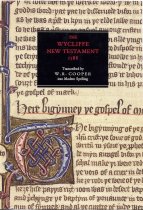Browse the Collection Record
Images

Metadata
Object Name |
Wycliffe New Testament |
Object ID# |
MC 1408 |
Artist (original) |
Translated by John Wycliffe |
Artist (replica) |
Edited by Dr. W. R. Cooper into modern spelling |
Date |
AD 1388 |
Description |
During a period of unrest John Wycliffe (c. 1329-84) appeared on the scene as the 'man of the hour'. His evaluation of the religious climate convinced him of the need to turn to the Scriptures as the paramount rule of life. This Latin scholar set the wheels of translation in motion without the use of the printing press. His work created a thirst for a Bible in the tongue of the common man. The two 14th century translations written under his name are the earliest complete manuscripts that we have of the Holy Bible in English. Interestingly, Wycliffe's Bible is also the first to use our modern chapter divisions, which were developed by the Archbishop of Canterbury, Stephen Langton, in the 13th Century. Verse divisions were not adopted until the mid-16th Century. Although John Wycliffe did not actually translate the Bible that is named after him, his preaching and writings inspired his followers, the Lollards, to translate the Bible from the Latin Vulgate into English. Wycliffe, an intellectual Augustinian who taught at Oxford University in the 1370s, believed that the centre of all Christian practice must be the Bible and that every person should have access to the Scriptures in their own tongue. Wycliffe's views brought into question the hierarchical practices of the Church, and his followers were persecuted by both Church and State. Their first translation, known as the Early Version of the Wycliffe Bible, made the text of the whole Bible available to the people of Britain in their own language for the first time. The text of the New Testament presented here, known as the Later Version, appeared around 1388, four years after Wycliffe's death. Its impact was so great that in 1401 a statute was issued banning it upon pain of death. Lollards were persecuted for their beliefs and their ownership of forbidden texts. These efforts, however, failed to stop reproduction of the texts and scribes continued to copy them faithfully, risking great dangers to themselves. Even after the advent of authorized, printed English Bibles in the sixteenth century, handwritten copies of the Wycliffe Bible were still cherished and read. This edition of the Wycliffe New Testament, published in association with the Tyndale Society, has been rendered into modern spelling and punctuation, so that over 600 years later, the modern reader can enjoy this remarkable text for themselves. Description is from the Jacket designed by Justin Howes. |
Place of Origin |
Britain |
Medium |
Bible |
Material |
hardcover (copy) |
Metzger Location |
Gallery |
Location of Original |
The British Library London |
Dimensions Details |
528 pages Height: 193 mm Weight: 130 mm |
